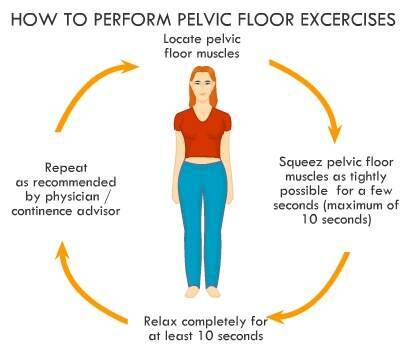Managing Your Incontinence
In many cases bladder weakness can be cured. It depends on what has caused your bladder weakness in the first place. A toilet habit training programme, change in diet or regular exercise may be all you need in order to regain control and your confidence. We always recommend you see your GP or local continence advisor so that they can recommend the best course of action.
- There are also different kinds of medication they may consider to help minimize or manage your condition.
- If you are using disposable or re-usable pads or underwear then making sure it is comfortable and fits closely to your body is important to minimize any chance of leaks and ensure you feel confident to get on with life.
- It is a good idea to make sure that getting to the toilet in a hurry is easy and that no obstacles stand in your way.
- Whatever you do, it is a good idea is to discuss your bladder weakness with your partner. Openly discussing your situation with them will be rewarded by a greater, mutual understanding and, probably a strong sense of relief.
Stress
Pelvic floor exercises are the best way to strengthen the pelvic floor. Your GP can refer you to a continence advisor or physiotherapist for specialist advice. You can get vaginal cones (small, plastic, cone-shaped weights) that you hold inside your vagina to help you do pelvic floor muscle exercises. They are available from some pharmacies.
Squeeze before you sneeze or cough to tighten your pelvic floor muscles and hold them tight to prevent leakage.
- Some women find that additional oestrogen improves the strength and elasticity of their muscles, so hormone replacement therapy may be a consideration.
- In some cases, but only if other treatment has not worked, your GP may refer you for a surgical assessment. This usually involves a procedure to raise your bladder into a better position and repair the effects of a weakened pelvic floor.
Urge
The best way to improve urge incontinence may be to retrain the bladder. Over time, you can gradually stretch the bladder so that it can hold more urine. This means that you will have more time to get to the toilet after you feel the ‘urge’ and you are less likely to leak urine. Your doctor, nurse, or continence advisor will explain how to do bladder retraining.
- Also using mental tricks can take your mind off the urge. For example, distract yourself by thinking of as many words as you can beginning with the letter A, and then work your way through the alphabet.
- Doing pelvic floor exercises can also help. They will not cure the bladder contractions that cause the urge, but stronger pelvic floor muscles will support your bladder and help minimize any leakages.
- If it stings when you pass urine you may have an infection (known as cystitis) and should see your GP or a medical professional. The urge incontinence will improve when the infection is treated.
Other Treatments
Treatments for anything which can cause increased pressure on the bladder, such as constipation, fibroids, etc. will help reduce the incidence of bladder weakness. Also weight loss may help if you're very overweight. There are also a variety of drugs available. They can have some effect but may need to be continued for several months at least.
What else can I do?
- Both men and women can do pelvic floor exercises to strengthen the pelvic floor muscles. Strengthening the pelvic floor muscles reduces the likelihood of experiencing bladder weakness later in life.
- Empty your bladder properly each time. Firstly sit up straight whilst you are passing urine with your feet on the floor. Empty your bladder then lean forward at the waist and lean from side to side to ensure that the bladder is completely empty, taking your time to do this.
- Pregnant women should start pelvic floor exercises during pregnancy and continue after the birth.
- Men can do pelvic floor exercises to avoid leaking after urinating. Heavy lifting can also weaken the pelvic floor muscles.
- Eat plenty of fresh fruit, vegetables and fibre to avoid constipation, which can press on the bladder and the urethra.
- Stopping smoking can reduce the likelihood of experiencing urge incontinence. Also smokers cough more frequently than non-smokers which can exacerbate the situation.
- Avoid diuretic drinks such as alcohol, and drinks which contain caffeine (i.e. coffee, cola, tea, etc.) as these cause your kidneys to produce more urine.
- Do not cut down on the amount of water you drink, in fact you should drink 3 to 4 pints (2 litres) a day. Drinking less will only make your urine more concentrated, which will irritate the bladder, causing you to urinate more often and may make urinating more painful. However, it is not recommended that you drink excessive amounts either as this could lead to distension of the bladder.
- You could try not drinking any fluids three hours before going to bed.
- Yoga: Yoga is known to help improve the health and stength of your pelvis, which in turn can help control your bladder. Because incontinence is often associated with anxiety and depression, people suffering from incontinence can benefit from yoga's emphasis on mediation and relaxation. Therefore yoga has also been linked to help relieve stress related incontinence.
Pelvic Floor Exercises
What are they?
Pelvic floor exercises are especially useful for stress incontinence and can reduce the effects of this condition considerably. They can be done at almost anytime or anywhere, at home, work or even queuing for a bus! Once you have learnt to tighten your pelvic floor muscles, you can squeeze them and hold when you sneeze, lift or jump to prevent leakage. However, please note that you may have to do them for a few months before you notice any improvement.
What is the "pelvic floor"?
The pelvic floor muscles are a group of muscles inside the pelvis that forms a floor in the body. They surround the urethra, vagina and rectum and should, along with the sphincter muscles, maintain control over these openings. The muscles should also support the urethra, bladder and womb and withstand all increases in abdominal pressure that occur during physical exercise.
If the pelvic floor muscles are weak the urethra can fall during exertion, resulting in leaking.
Where is it?
In order to find your pelvic floor muscles try interrupting the flow when you urinate. Feel which muscles you are using to do this. These are the same muscles you use when trying to hold back wind. These are the muscles you need to work on.
Correct contraction of the pelvic floor muscles feels like a small lift under the pelvis up into the body. There should be no accompanying movement of other parts of the body, e.g. the buttocks, stomach or the inner thighs. If you have a problem identifying the right muscles or if you are not sure that you are training correctly contact your doctor and/or physiotherapist.
How do I do them?

- Stand, sit or lie with your knees slightly apart (sitting is easiest). Now imagine that you are trying to stop yourself passing wind from the back passage; to do this, you must tighten the muscles round the back passage. Squeeze and lift those muscles as if you really do have wind: you should be able to feel the muscles move and the skin round the back passage tightening. Your legs and buttocks should not move at all.
- Next, imagine that you are sitting on the toilet passing urine. Imagine yourself trying to stop the stream of urine (the stop test) – really try hard. You will be using the same group of muscles as in the first exercise, but you will find it more difficult.
- Next time you go to the toilet to pass urine, try the stop test about half way through emptying your bladder. (If the flow of urine speeds up, you are using the wrong muscles.) Once you have stopped the flow of urine, relax and allow the bladder to empty completely. Do not worry if you find you can only slow up the stream, and cannot stop it completely. Do not do this every time but only to help you identify the correct muscles.
- If you are unsure you are exercising the right muscles, put one or two fingers in the vagina and try the exercise to check. You should feel a gentle squeeze if you are exercising the pelvic floor. A common mistake is to just clench your buttocks and hold your breath; if you cannot hold a conversation at the same time, you are doing the exercises wrongly. Counting aloud while you do the exercises will stop you holding your breath. Do not tighten the tummy, thigh or buttock muscles or cross your legs. Only use your pelvic floor muscles.
- When you have learned to use the muscles correctly train as hard as you can without using other muscle groups. Gradually increase the number of repetitions to 10 times. Try to hold each muscle contraction for 6-8 seconds.
It is never too late to start pelvic floor exercises. No matter what you age or condition they can cause improvements in your condition.
Bladder Retraining
Bladder retraining should only be done after having consulted your Doctor, Continence Advisor or health professional.
Bladder retraining is based on passing urine by the clock at regular intervals. If holding on is difficult, distract yourself by watching TV or making a phone call.
